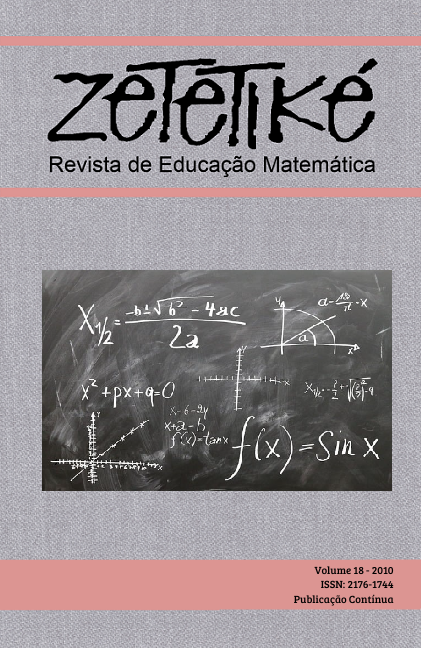Abstract
The paper concerns the construction of the combinatory reasoning
when problems of Cartesian product are solved by 3rd to 6th grade Elementary
School students’. Stemming from the revision of hierarchies described in earlier
studies, it is based on Piaget’s and Vergnaud’s proposals. The participants, 110
students attending State Elementary Schools (mean age 10;5), answered a paper
and pencil instrument containing four multiplicative problems of Cartesian
product. A qualitative and a quantitative analysis result in a revised hierarchy of
the combinatory reasoning, and show its absence on solutions in all grades and
problems, but a significant tendency to advanced solutions in 4th grade to some
problems. Concerning the hierarchy, the discussion underlines the progressive
combination of variables; the passage from arithmetical to algebraic reasoning
and from additive to multiplicative schemata; the progressive overture to the
possibilities in its interplay with the necessities. Methodological restrictions and
implications for mathematical education are presented.
References
ARCAVI, A.; FRIEDLANDER A.; HERSHKOWITZ, R. L’algèbre avant la lettre. Petit X, n. 24, p. 61-71, 1989-90.
COLLIS, K. F. A study of concrete and formal operations in school mathematics: a Piagetian viewpoint. Australian Council for Educational Research Series 95. Hawthorn, Victoria: ACER, 1975.
ENGLISH, L. Children’s use of domain-specific knowledge and domain-general strategies in novel problem solving. British Journal of Educational Psychology, n. 62, p. 203-216, 1992.
FUJII, T. A clinical interview on children’s understanding and misconceptions of literal symbols in school mathematics. In: I. HIRABAYASHI et al. (Ed.). Proceedings of the 17th PME International Conference. Tsukuba: University of Tsukuba, 1993. v.1, p. 173-180.
HERSCOVICS, N.; LINCHEVSKI, L. Pre-algebraic thinking: Range of equations and informal solution processes used by seventh graders prior to any instruction. In: F. FURINGHETTI (Ed.). Proceedings of the 15th. PME International Conference, Assisi: PME, 1991. v. 2, p.173-180.
INHELDER, B.; PIAGET, J. De la lógica del niño a la lógica del adolescente. Trad.de M. T. Cevasco. Buenos Aires: Paidos, 1972. Trabalho original publicado em 1955.
KUCHEMANN, D. Algebra. In : HART, K. (Ed.). Children’s understanding of mathematics: 11 -16. London/UK: John Murray, 1981. p. 102-119.
LEMOYNE, G. et al. Addition, addition répetée, multiplication: un trajet éclairé par les schèmes d’action. In : ARTIGUE, M. et al. (Ed.), Vingt ans de Didactique des Mathématiques en France. Grenoble: La Pensée Sauvage, 1994. p. 236-242.
LINS, R.; GIMENEZ, J. Perspectivas em aritmética e álgebra para o século XXI. Campinas: Papirus, 1997. (Coleção Perspectivas em Educação Matemática).
MEKHMANDAROV, I. Analysis and synthesis of the Cartesian product by kindergarten children. In: NAKAHARA, T.; KOYAMA, M. (Ed.), Proceedings of the 24th. Annual Conference of the PME. Hiroshima: Hiroshima University, 2000. v. 3, p. 295-301.
MORO, M. L. F.; SOARES, M. T. C. Níveis de raciocínio combinatório e produto cartesiano na escola fundamental. Educação Matemática Pesquisa, v. 8, p. 99- 124, 2006.
NUNES, T.; BRYANT, P. Crianças fazendo matemática. Trad. de S. Costa. Porto Alegre: Artes Médicas, 1997.
PIAGET, J.; BERTHOUD-PAPANDROPOULOS, J.; KILCHER, H. Multiplicação e associatividade multiplicativa. In: J. PIAGET (Dir.), O possível e o necessário II - A evolução dos necessários na criança. Trad. de B. M. de Albuquerque Porto Alegre: Artes Médicas, 1986. p. 72-88. Original publicado em 1983.
PIAGET, J.; SZEMINSKA, A. A gênese do número na criança. Trad. de C. M. Oiticica. Rio de Janeiro: Zahar, 1971. Original publicado em 1941.
VERGNAUD, G. Multiplicative structures. Em: LES, R. e LANDAU, M. (Org.), Acquisition of Mathematics: concepts and processes. London: Academic Press, p. 127-174, 1983.
VERGNAUD, G. L’enfant, la mathématique et la réalité. 3. ed. Berne: Peter Lang, 1985.
VERGNAUD, G. La théorie des champs conceptuels. Recherches en Didactiques des Mathématiques, v. 10, n. 23, p. 133-170, 1990.

This work is licensed under a Creative Commons Attribution-NonCommercial-NoDerivatives 4.0 International License.
Copyright (c) 2014 Zetetiké: Revista de Educação Matemática

